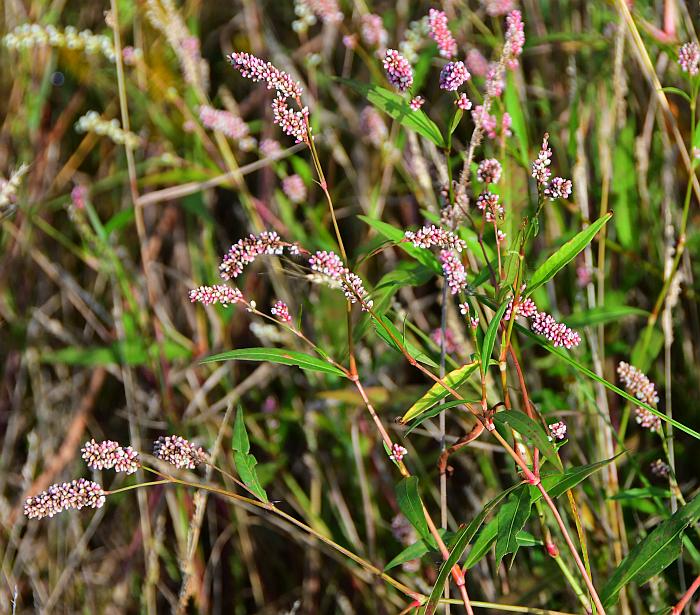Persicaria maculosa Gray
Lady's Thumb

Introduced
CC = *
CW = -3
MOC = 60
© SRTurner
Persicaria maculosa GrayLady's Thumb | |
 |
Introduced CC = * CW = -3 MOC = 60 |
© SRTurner |
|
Family - Polygonaceae Habit - Annual, taprooted forb, the stems also occasionally rooting at the lower nodes.
Stems - Spreading to erect, to 70 cm, glabrous or appressed-hairy, not glandular, typically reddish at nodes. Ocreae persistent, usually tearing with age, 4-30 mm long, somewhat inflated toward the base, tan to light brown and papery throughout, truncate, not oblique at the tip, lacking a flange of tissue at the tip, the margin with bristles 1.0-3.5 mm long, the surface glabrous or appressed-hairy, not gland-dotted.
Leaves - Alternate, simple. Petioles absent or to 0.8 cm long. Leaf blades 5-10 cm long, 1.0-2.5 cm wide, linear-lanceolate to lanceolate or narrowly ovate, angled or tapered at the base, angled or tapered to a sharply pointed tip, the surfaces glabrous or sparsely appressed-hairy especially along the main veins, unarmed, the undersurface sometimes with impressed glands, the upper surface often with a reddish or purplish, chevron-to crescent-shaped or triangular area.
Inflorescences - Terminal and axillary from the upper leaves (sometimes also with small clusters of flowers at the median and lower nodes), solitary or more commonly several to numerous per main stem, 1.0-4.5 cm long, 7-12 mm wide, erect or ascending, straight, dense, uninterrupted, the stalk 1-5 cm long, glabrous (occasionally appressed-hairy elsewhere), not glandular. Ocreolae mostly overlapping, the margins glabrous or more commonly with bristles 0.2-1.0 mm long, the surface glabrous, not gland-dotted.
Flowers - Perfect, 4-14 per fascicle, all similar. Perianth white to greenish white toward the base, pinkish-tinged to pink toward the tip, bell-shaped, not gland-dotted, the tepals 4 or 5, 2.0-3.5 mm long, fused below the midpoint, the nerves irregularly few-branched, forming a network toward the base (not anchor-shaped). Stamens 4-8, not exserted, the anthers yellow or pink. Styles 2-or 3-branched from near the base, not exserted, not persistent.
Fruits - Achenes 2-3 mm long, 1.5-2.5 mm wide, not or only slightly exserted, discoid or 3-angled, beakless, the faces flat or slightly concave, lacking a central hump, the surface smooth, dark brown to black, shiny.
Flowering - May - October. Habitat - Streambanks, spring branches, sloughs, fens, bottomland forests, openings of mesic upland forests, moist swales in sand prairies, fields, gardens, ditches, railroads, roadsides, and open disturbed areas; occasionally emergent aquatics. Moist to wet waste ground, disturbed sites, meadows, streambanks, roadsides, railroads. Origin - Native to Eurasia. Lookalikes - Several other pink-flowered species of Persicaria. Other info. - This species is found in wet areas across most of Missouri, and across most of the continental U.S. It can sometimes be recognized by the characteristic purple splotch in the center of the leaf; however, this is not always present. The inflorescence stalks are neither hairy nor glandular. Characters to look for are stem node ocreae with bristles at the top (though these are usually short) and pinkish inflorescences typically about 1 cm in diameter. There are normally several of these on each plant. Older specimens often have bare, reddish lower stems with conspicuous swellings. Photographs taken at the Kansas City Zoo, 5-30-99 and 5-11-00 (DETenaglia); also at Creve Coeur Lake Park, St. Louis County, MO, 8-6-2020, near Labadie, Franklin County, MO, 8-6-2020, and at East Central College, Franklin County, MO, 9-14-2023 (SRTurner). |